Contents
Every 2-3 months, private traders who breed ducks face a problem: how to pluck a duck. True, before plucking it, the duck must be slaughtered. Slaughtering ducks is only a psychological problem for people who have not dealt with it.
Ducks are slaughtered at the age of 2-3 months. After the ducklings are overgrown with feathers, but the juvenile molt has not yet begun. A duck slaughtered during the molting period is difficult to pluck properly. There will definitely be stumps from which new feathers should have grown. If the ducks did not have time to slaughter at 3 months, they are slaughtered after the end of the juvenile molt.
At 2 months, ducks usually have not yet gained subcutaneous fat and their skin is very thin. The weight of the ducklings is also small, but this is at the discretion of the owner. You need to pluck such a duck very carefully. When capturing too much of a bunch of feathers, they are torn off along with the skin.
In order not to cut the throat of a duck with a blunt knife, the tool is first sharpened. After catching a duck, her throat is cut near the head under the beak. As a result of cutting large blood vessels, the duck goes into shock and no longer feels pain.
How to pluck a duck
The best way to quickly pluck a duck is to place it in a picker. But this car costs so much that most owners prefer to handle it manually.
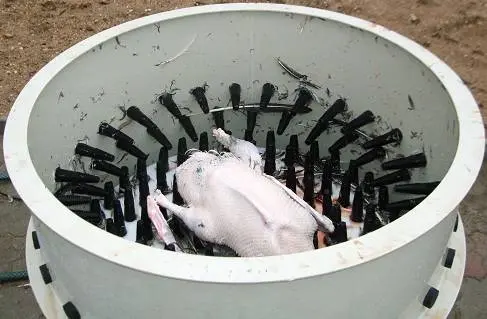
It is believed that before plucking the ducks must be kept for 4 hours. Then the feather is better separated from the skin. But we must not forget that decomposition in the heat begins very quickly. And it starts with the intestines.
After slaughter, the duck is placed in a container with boiling water. Usually, each duck owner has his own secrets of “soaking” the duck carcass and then plucking it. One way: immerse the duck carcass in boiling water twice. This works well when you have to pluck an old duck.
Since usually more prolific young ducks are left for the next year, the “old” ducks have to be slaughtered annually.
Another way to scald a duck is in hot water with a couple of drops of detergent added. It is believed that in this case, fat is washed off duck feathers and it becomes much easier to pluck a duck at home.
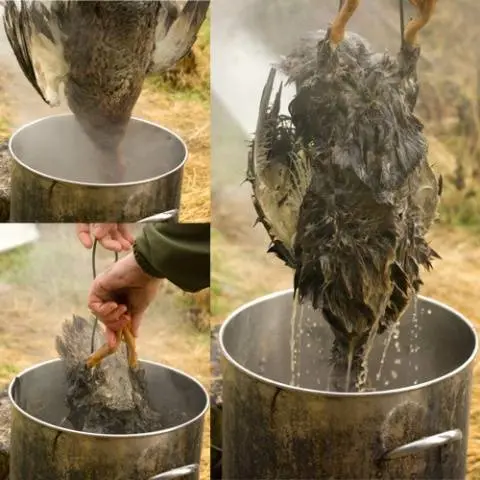
There is also a dry way of plucking a duck carcass. Everything is the same, only without soaking in water. The disadvantages of this method:
- in fact, feathers from a duck carcass are torn out much harder, especially flight feathers from the wings and tail feathers from the tail;
- dry feathers scatter everywhere, sticking to hands and clothes.
The advantage of the dry method is better singeing of the plucked duck carcass.
But the principles of plucking are the same, so dry-cleaners can skip the step of scalding the duck carcass.
So, the duck carcass is scalded. With or without detergent. Plucking ducks is carried out, starting with large fly and tail feathers.
After that, the feathers begin to be plucked from the carcass in the direction of growth, since otherwise the skin can be damaged in a young duck. In older ducks, sometimes you have to pluck the feathers in the opposite direction, so they are more easily torn out. The video shows the process of plucking a duck very well.
Since it will not be possible to pluck the duck completely cleanly either manually or with the help of a machine, after plucking the duck carcass must be singeed. Singe the duck either with a blowtorch or on a gas burner. In the latter case, you will have to hold the duck carcass by the paws and wings. When singeing with a blowtorch, the duck can simply be hung from something.
The feather that has absorbed water burns out later than the duck skin begins to bubble. To prevent this from happening, the duck must be dried before singeing. After singeing, the cinders from the duck carcasses are cleaned or washed off and proceed to the next step.
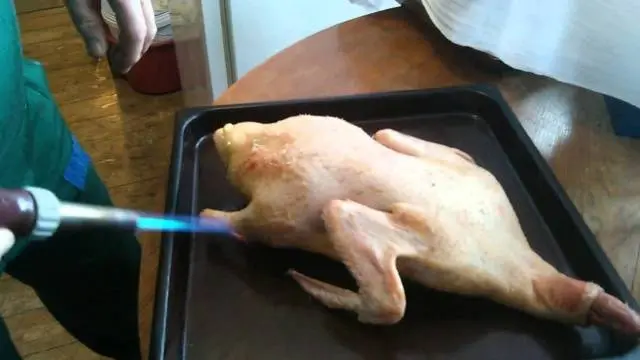
Consumption of ducks
Task: get rid of the intestines without damaging it. When gutting a duck, you need to be careful not to accidentally cut through the intestines.
During this time, the intestines of ducks are almost completely freed from the contents.
The most convenient scheme for gutting a duck is when the entire duck intestine remains intact. Better not to cut it in pieces. The contents of the intestines can enter the abdominal cavity of the duck carcass and spoil the meat.
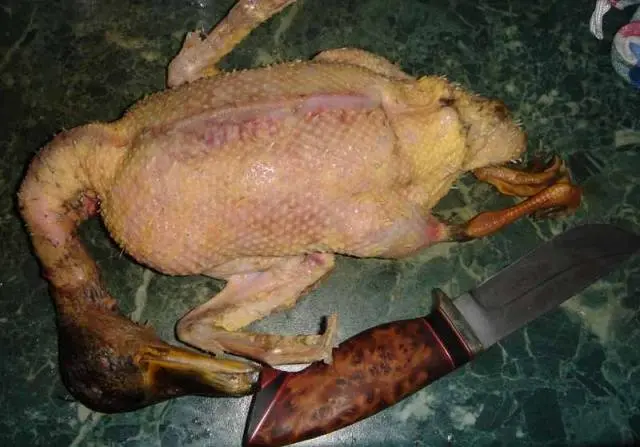
How to properly cut a duck:
- with a knife, an incision is made along the flexor tendons between the metatarsus and the thigh and the duck paw is bent in the opposite direction to the natural one;
- the duck’s paw breaks at the joint. The remaining tendons are cut with a knife. Do the same with the second paw;
- lay the duck on its back, neck to itself;
- hand from below pull the skin on the neck;
- a sharp knife is carried along the neck of the duck along, cutting the skin. The fingers will be protected by the neck, but it is better that the knife does not slip off;
- pick up the cut skin and tear off the skin from the neck:
- the esophagus and trachea are torn off along with the skin. They are torn off from the skin to the maximum possible depth inside the duck. Everything from this side;
- turn the duck with its tail towards itself and carefully, with a sharpened tip of a knife, make an incision in the skin from the keel towards the anus, making sure not to touch the intestines;
- stick their fingers into the hole formed and tear the incision with their fingers;
- the duck has thin bones closer to the tail. The skin is unrolled between the tail and the bone with two fingers and a transverse incision is made. When cut on both sides, the anus will turn out to be almost separated from the duck tail;
- they capture the anus with the intestine and cut it out in the direction “from the duck” – from bottom to top;
- they stick their hand inside the duck carcass, tearing the films connecting the offal with the duck body;
- reach for the esophagus and grab it with the middle finger, pinching it between two adjacent ones;
- with a raking motion, the gastrointestinal tract is pulled out of the duck along with the liver.
The main work is done. The intestines are not damaged and the contents did not stain the duck carcass.
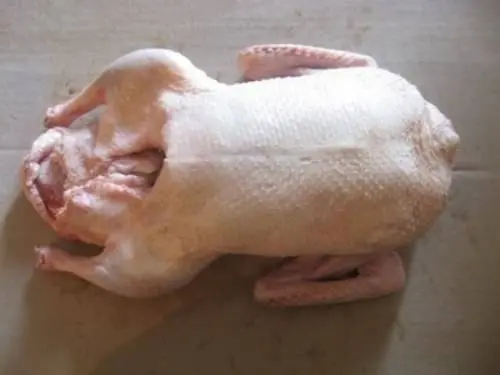
In the duck carcass, there was still a heart, lungs and trachea. Take out the trachea and heart. The lungs are attached to the ribs, they are taken out at will. The heart is washed from the blood and left to itself, the trachea is given to the four-legged starving, if they are in the house.
Now we need to deal with the stomach and liver. The liver must be carefully separated from the intestine so as not to damage the gallbladder.
The duck stomach is cut off from the intestines and cut open to clean out the contents. The tape also needs to be removed. Interestingly, the gastric film can be removed very easily, or it can “hold on to the last” and this circumstance does not depend on the age of the duck, or on the diet, or on the conditions of keeping the ducklings. But you need to remove the film, it gives bitterness during cooking.
After you have dealt with the insides, they return to the duck carcass. It is also necessary to cut out the sebaceous gland on the tail of the duck, as this specific fat will spoil the whole dish with a smell.
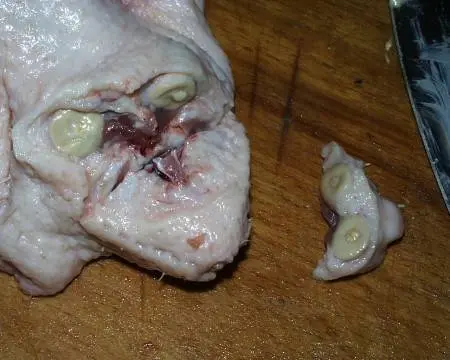
There is no meat, only fat. By carefully incising the soft tissues around the tail up to the spine, the tail can be easily torn off in a circular motion.
After the duck is gutted, we decide whether it is necessary to skin it.
How to Skin a Duck
The first thing to do is to decide whether to do it. If you need to get a fatty dish, you can’t skin the duck. If the goal is to reduce the amount of fat in food, skinning the duck is a must.
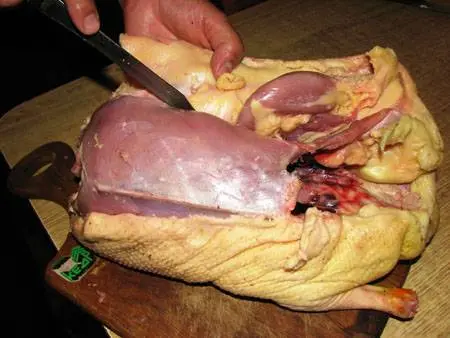
All duck fat is concentrated under the skin. Removing the skin from the duck, get lean meat.
The skin on the neck of a duck is rough and tastes like an amateur. When skinned, you can cut it along with the skin on the back. We remove the skin on the back, as far as it will be removed. It is removed usually approximately to a waist. Starting from the lower back, there is only fat between the skin and bones, so the skin will have to be cut off here. To the maximum, the skin was removed from the back of the duck. Now chest.
On the chest, we make an incision along the midline, we cling to the skin and remove it, helping ourselves to cut the films with a knife. The skin is removed in this place very easily. Next, as far as possible, remove the skin from the sides and legs. The skin is removed from duck wings very poorly, but there is almost no fat under it. Wings can be left. Skinned duck is more convenient to boil than to fry.
Cutting the duck into portions

After the duck is gutted and possibly skinned, it must be cut into portions. Butchering a duck is best to start with the legs. Then later it will be better to see where to cut the sirloin meat. If there is skin, it is cut at the junction of the legs and torso. After that, the duck leg is turned out of the hip joint and the remaining tendons and skin are cut.
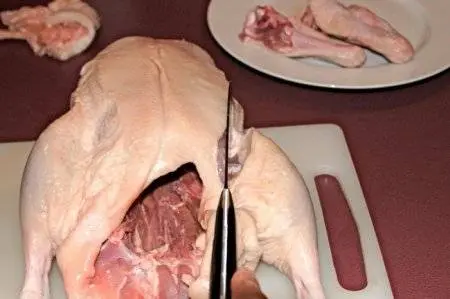
The fillet parts are cut along the keel bone and the thymus bone (it is semicircular in the duck) and the meat is separated from the skeleton. Cut the muscles near the wing. The fillet is also ready.
Wings, like legs, cut at the joint. These pieces will make portions for the roast.
Usually the housewives themselves decide how to butcher the duck. Sometimes a fillet and a wing act as a portioned piece at the same time. Someone cuts a duck into two halves. And someone, when cutting into portioned pieces, cuts wings for soup.
Everything that remains after cutting the duck goes into the category of a soup set. Later, soup can be made from duck leftovers.
Conclusion
The ability to pluck and gut ducks is very useful for those who want to get a couple of kilograms of very tasty and healthy meat. At the same time, it is not even necessary to be able to cut duck carcasses into portioned pieces. Grilled whole duck is also very tasty.










ördəyi yay